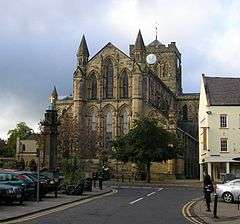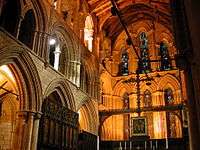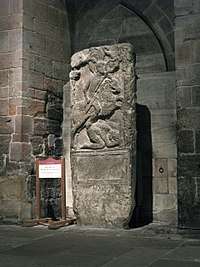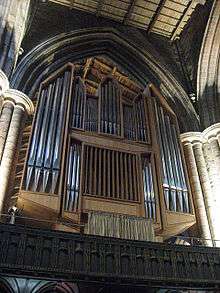Hexham Abbey
| Hexham Abbey | |
|---|---|
 East end of Hexham Abbey | |
| Country | United Kingdom |
| Denomination | Church of England |
| Previous denomination | Roman Catholic |
| Churchmanship | Broad Church |
| Website | hexhamabbey.org.uk |
| Administration | |
| Parish | Hexham |
| Diocese | Newcastle |
| Province | York |
| Clergy | |
| Rector | Dagmar Winter |
| Priest(s) | Matthew Hunter |
| Laity | |
| Director of music | Michael Haynes |
| Organist(s) | Keith Dale |

Hexham Abbey is a leading historical attraction and Grade I listed place of Christian worship dedicated to St Andrew, in the town of Hexham, Northumberland, in northeast England. Originally built in AD 674, the Abbey was built up during the 12th century into its current form, with additions around the turn of the 20th century. Since the Dissolution of the Monasteries in 1537, the Abbey has been the parish church of Hexham. In 2014 the Abbey regained ownership of its former monastic buildings, which had been used as Hexham magistrates' court, and subsequently developed them into a permanent exhibition and visitor centre, telling the story of the Abbey's history. There is also a Refectory Café and gift shop, catering to over 100,000 visitors each year.
History
There has been a church on the site for over 1300 years since Etheldreda, Queen of Northumbria made a grant of lands to St Wilfrid, Bishop of York c.674. Of Wilfrid's Benedictine abbey, which was constructed almost entirely of material salvaged from nearby Roman ruins, the Saxon crypt still remains; as does a frith stool, a 7th/8th century cathedra or throne.[1] For a little while around that time it was the seat of a bishopric.
In the year 875, Halfdene (Halfdan Ragnarsson) the Dane ravaged the whole of Tyneside and Hexham Church was plundered and burnt to the ground.[2]
About 1050, one Eilaf was put in charge of Hexham, although as treasurer of Durham, he probably never went there. Eilaf was instructed to rebuild Hexham Church which then lay in utter ruin. His son Eilaf II completed the work, probably building in the Norman style.[2]
In Norman times, Wilfrid's abbey was replaced by an Augustinian priory. The current church largely dates from c.1170–1250, built in the Early English style of architecture. The choir, north and south transepts and the cloisters, where canons studied and meditated, date from this period.
The east end was rebuilt in 1858.[3] The Abbey was largely rebuilt during the incumbency of Canon Edwin Sidney Savage who came to Hexham in 1898 and remained until 1919. This mammoth project involved re-building the nave, whose walls incorporate some of the earlier church and the restoration of the choir. The nave was re-consecrated on 8 August 1908.
The church was recorded as Grade I listed in 1951.[3] In 1996 an additional chapel was created at the east end of the north choir aisle; named St Wilfrid's Chapel, it offers a place for prayer or quiet reflection.
Stained glass
Four of the stained glass windows in the Abbey are the work of Jersey-born stained glass artist Henry Thomas Bosdet who was commissioned by the Abbey. The east window was the first project and was installed about 1907. Two smaller windows followed and the large west window was installed in 1918.[4]
Crypt
The crypt is a plain structure of four chambers. Here were exhibited the relics which were a feature of Wilfred's church. It consists of a chapel with an ante-chapel at the west end, two side passages with enlarged vestibules and three stairways. The chapel and ante-chapel are barrel-vaulted. All the stones used are of Roman workmanship and many are carved or with inscriptions.[2] One inscription on a slab, partially erased, is:
IMP •CAES •L •SEP • • • |
Translated it means The Emperor Lucius Septimus Severus Pius Pertinax and his sons the Emperor Marcus Aurelius Antonius Pius Augustus and Publius Geta Caesar the cohorts and detachments made this under the command of ….. The words erased are of great interest. After the Emperor Geta was murdered by his brother Caracalla, an edict was made at Rome ordering that whenever the two names appeared in combination that of Geta was to be erased. This was done, but so poorly that the name can still be read.[2]
Bishopric of Hexham
.jpg)
The first diocese of Lindisfarne was merged into the Diocese of York in 664. York diocese was then divided in 678 by Theodore of Tarsus, forming a bishopric for the country between the Rivers Aln and Tees, with a seat at Hexham and/or Lindisfarne. This gradually and erratically merged back into the bishopric of Lindisfarne. Eleven bishops of Hexham followed St. Eata, of which six were saints.
No successor was appointed in 821, the condition of the country being too unsettled. A period of disorder followed the Danish devastations, after which Hexham monastery was reconstituted in 1113 as a priory of Austin Canons, which flourished until its dissolution under Henry VIII. Meantime the bishopric had been merged in that of Lindisfarne, which latter see was removed to Chester-le-Street in 883, and thence to Durham in 995.
Bishops
- Eata, 'bishop of Bernicia', with his seat at Hexham and/or Lindisfarne, died 685, succeeded by John of Beverley (Bede, Ecclesiastical History IV.12)
- Trumbert, 682, as 'bishop of Hexham', at the same time as Trumwine's installation, with Eata continuing as bishop at Lindisfarne
- Cuthbert of Lindisfarne, 685, after Tumbert's din deposition, moving his seat to Lindisfarne to become bishop of Lindisfarne (Bede, IV.28)
- St. John of Beverley (685–705) (Bede, V.2). From then on, the seat was at Hexham, and the bishopric of Lindisfarne continued independently, with Eadberht succeeding Cuthbert
- St. Wilfrid, who, resigning the See of York, died as Bishop of Hexham in 709
- St. Acca, Wilfrid's successor, from 709 (Bede, V.20)
- Frithubeorht 734–766
- St. Eahlmund 767–781
- Tilbeorht 781–789
- Æthelberht 789–797 transferred from Whithorn
- Heardred 797-800
- Eanbehrt 800–813
- Tidfrith, last bishop in this line, who died about 821
Rectors
- Canon Barker 1866 – 18[98?]
- Edwin Sidney Savage 1898 – 1918
- James Vaux Cornell Farquhar 1919 – 1945
- Archibald George Hardie 1945 – 1962
- Rowland Lemmon 1962 – 1975
- Bishop Anthony Hunter 1975 -1979
- Timothy Withers Green 1979 – 1984
- Michael Middleton 1985 – 1992
- Canon Michael Nelson 1992 – 2004
- Canon Graham Usher 2004 – 2014
- Canon Dr Dagmar Winter 2015-
Notable burials
Tombstone of Flavinus, Roman Standard Bearer

The tombstone of Flavinus, is one of the most significant Roman finds in Britain. It can be found in the Abbey in front of a blocked doorway at the foot of the Night Stair. Flavinus was a Roman cavalry officer who died aged 25 in the first century. The slab is thought to have once stood near the fort of Coria near Corbridge. It was brought here as a building stone in the 12th century. The slab was laid face upwards in the foundations of the cloister and was rediscovered in 1881.[5]
Organ

In 1865 the Abbey acquired a second-hand organ from Carlisle Cathedral dating from 1804. It was installed in Hexham by Nicholson of Newcastle and opened on 19 October 1865.[6] In 1905 this was rebuilt by Norman and Beard with Sir Frederick Bridge of Westminster Abbey as the consultant.
In 1974 a new instrument by Lawrence Phelps of Pennsylvania was installed. It is a two manual 34-stop mechanical action instrument.[7]
Organists
- George Agnew Reay 1820 - ????
- William Turner ???? – 1834[8] – 1855[9] – 1865
- John Nicholson 1865[10] – 1878
- James Price 1878 – 1882 (afterwards organist of St. Margaret's Church, Ipswich)
- Thomas Simpson Camidge 1882 – 1889
- Richard Seaton 1889 - 1909
- Ronald Richardson Potter 1909 – 1911
- Newell Smith Wallbank 1911 – 1917 (later organist of Wakefield Cathedral)
- Harry William Tupper 1917 – 1918 (afterwards Organist of Southwell Minster)
- Hubert Henry Norsworthy 1918
- Newell Smith Wallbank 1918 – 1926 (later organist of Wakefield Cathedral)
- Cecil S. Richards 1926
- Reginald Tustin Baker 1928–1929 (later organist of Sheffield Cathedral)[11]
- Thomas Christy 1933 – 1945 (formerly sub-organist of Newcastle Cathedral 1928 – 1933)
- Alfred Southcott Morrish 1945 – 1948
- Frederick Hudson 1948[11] – 1949
- Dr Reginald Cooper
- Ronald Womersley
- Terence Atkinson 1965 – 1985
- John Green 1985 – 2000 (also Director of Music at Dame Allan's Schools, Newcastle, 1967–1990)
- Michael Haynes 2000 – 2011
- Marcus Wibberley 2011 –2017
- Michael Haynes 2017 -
Assistant organists
- Colin Basil Fanshaw 1947 – 1949[11]
- Dorothy Alder
- John Green 1961 – 1968
- Ron Lane 1969 – 1977
- John Green 1977 – 1983
- Henry Wallace 1983– 1999
- Hugh Morris 2001 – 2009 (currently director of music at Derby Cathedral)
- Alexander Woodrow 2009 – 2012 (later director of music at Bradford Cathedral and currently director of music at Solihull School)
- Andrew Wyatt 2012 – 2015 (currently assistant organist at Chester Cathedral)
- Michael Haynes 2015 - 2017 (formerly director of music 2000 - 2011, currently director of music 2017-)
- Keith Dale 2017 -
Choirs
Hexham Abbey Boys' Choir consists of boys' and men's voices and sings choral evensong on Wednesdays in addition to morning and evening services on the second and fourth Sundays of the month. The choir has made two CDs in recent years and has toured to Paris (2007), Rome (2009), Hanover (2011), Berlin (2012), Antwerp (2014) and Tallinn (2015), in addition to several tours within Great Britain. Several past members of the choir have gone on to win choral/ organ scholarships at Oxford and Cambridge colleges. The choir has appeared on BBC Songs of Praise.
Hexham Abbey Girls' Choir consists of girls and men and sings for the Parish Eucharist & Choral Evensong on the third Sunday of the month. The girls also sing with the boys on the fourth Sunday of the month and girls' voices also sing evensong on Thursdays. The choir began in September 2001 and is divided into junior & senior choristers aging from 7 - 18. The choir has toured to Dublin (2007), Paris (2009), Hanover (2011), Berlin (2012) and several other places.
Hexham Abbey Chamber Choir is entirely made up of adults. They sing evensong on the first Sunday of the month and when the other Abbey Choirs are unavailable. It has appeared live on BBC 4 Sunday Worship.
See also
References
- ↑ "Old ruins, new world". British Archaeology.
- 1 2 3 4 Graham, Frank (1992). Hexham and Corbridge A Short History and Guide. Thropton, Rothbury, Northumberland: Butler Publishing. pp. 2, 4, 5. ISBN 0-946928-19-3.
- 1 2 Historic England. "The Priory Church of St Andrew (1042576)". National Heritage List for England. Retrieved 14 August 2018.
- ↑ Dixon, Rebecca. "Documentary sheds new light on Abbey windows". Hexham Courant (Friday, 3 July 2009): 19.
- ↑ "The Flavius tombstone". wessexarch.co.uk. Retrieved 14 December 2017.
- ↑ "Ecclesiastical Intelligence, Hexham Abbey Church". Newcastle Journal. Newcastle. 20 October 1865. Retrieved 16 June 2015.
- ↑ Wright, Donald. Hexham Abbey. The Organ. Hexham: Peter Robson Ltd.
- ↑ 1834 Pigot's Directory for Northumberland
- ↑ 1855 Whellan's Directory of Northumberland
- ↑ The Newcastle Courant (Friday 1 September 1865). Missing or empty
|title=(help) - 1 2 3 Who's Who in Music. London (First Post-war Edition): Shaw Publishing Co. Ltd. 1949.
External links
| Wikimedia Commons has media related to Hexham Abbey. |